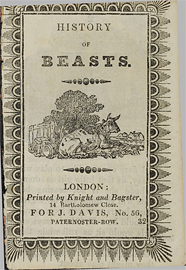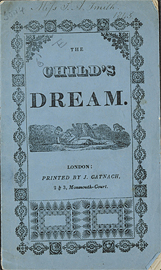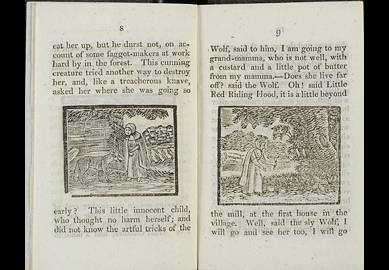The woodcut illustrations that adorned chapbooks were designed to attract the reader by offering a visual component to the text, but they were rarely related to the subject matter and contributed little or nothing to the actual story. In many cases, chapbooks and broadsides were purchased merely for their woodcuts, which could then be used "to decorate private houses or alehouses" (Stott 171). The suitability of an image for a particular text was not a great concern for publishers, who often re-used whatever stock images were available, and recycled images for multiple texts. Publishers were free to exercise their own discretion in the assemblage of text and image and, because chapbooks were usually reprinted from old editions, there was no authorial presence to curb this practice.
 PN970 D38 H5 1825
PN970 D38 H5 1825
The use of woodcuts was also greatly dependent on the stringent limitations of the chapbook format as they often functioned as padding to supplement the length of chapbooks. For example, publishers faced with a story that was either too long or too short could solve the problem rather inelegantly "by cutting the text or by the use of woodcut illustrations" (Neuburg [1968] 24). In other words, although the illustrations that adorned chapbooks were not necessarily intended to "illustrate" the text, they could often influence the length and layout of the story. This practice lends another dimension to the use of woodcuts because it demonstrates how "the literary contents of a book…may [be] modified for non-literary reasons" (Howard-Hill 15).
Woodcuts were produced by making sharp, clean cuts into the end of a piece of soft wood, such as pear, leaving the image to be printed in "as high relief as possible" (McKerrow 119). Woodblocks could be loaded into the press next to the printer's type, and so they were far easier to use than copper engravings, which required intaglio printing on a separate press. Woodcuts could also produce more impressions without deteriorating: unlike copper engravings, which would only yield a few hundred impressions, woodcuts could yield several thousand, and the time needed for each impression was shorter.

PN970 B73 H5 1810
Woodcut decorations, such as borders and ornaments, can also tell us much about a book's publishing history. According to Ronald McKerrow, the rougher and simpler woodcuts were unlikely to have been borrowed or copied by rival printers. Their occurrence, therefore, in two different texts
 PN970 C3 C4 1813
PN970 C3 C4 1813

PN970 K4 E6 1810
It was common for printers to recycle, borrow, and even steal from one another and, as a result, it is not unusual to find the same woodcuts "used for completely different subjects" (Weiss 4). However, the practice of recycling woodblocks for multiple texts caused a gradual decline in the visual quality of chapbooks and, in the eighteenth century, "chapbook illustrations seemed to become cruder than ever…[as] old cuts were getting worn from constant use" (Weiss 4). Woodcuts fell out of use as steel plate engraving increasingly replaced copper at the beginning of the early nineteenth century. Steel is much harder than copper, which allowed for more impressions to be produced before the plate deteriorated. Woodcuts made a slight comeback in the 1820s and 30s with the 'wood engraving' revival led by Thomas Bewick, but these would hardly have resembled the crude woodcuts of previous centuries. Wood engravings were incredibly detailed and, because the images were carved into hardwood, they could produce many more impressions than their inferior softwood predecessors.  PN970 D39 C86 1814
PN970 D39 C86 1814
| < Prev | Next > |

